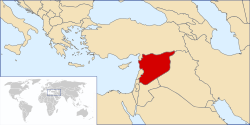Syria: Incendiary Weapons Used In Populated Areas, Says HRW
The Syrian military has used air-delivered incendiary bombs in at least four locations across Syria since mid-November 2012, Human Rights Watch said Tuesday. The conclusion is based on interviews with four witnesses and multiple videos analyzed by Human Rights Watch.
The Syrian military should cease its use of incendiary weapons immediately, Human Rights Watch said. A total of 106 nations have prohibited the use of air-delivered incendiary weapons, which cause serious burns, in populated areas, but Syria has not banned the weapons.

“We’re disturbed that Syria has apparently begun using incendiary munitions, as these weapons cause especially cruel civilian suffering and extensive property destruction when used in populated areas,” said Steve Goose, Arms division director at Human Rights Watch. “Syria should stop using incendiary weapons in acknowledgment of the devastating harm this weapon causes.”
Incendiary weapons can contain any number of flammable substances, including napalm, thermite, or white phosphorus and are designed to set fire to objects or to cause burn injuries. They are not chemical weapons, which kill and incapacitate by the toxic properties of the chemicals released.
Incendiary weapons produce extremely painful burns, often down to the bone, and can also cause respiratory damage. The burns are difficult to treat, especially in conflict areas lacking adequate medical facilities, and the treatment itself can be excruciating. Permanent scarring and disfigurement can lead to social ostracism. Incendiary weapons also cause fires to infrastructure due to their broad area effect, which means they cannot be used in a way that discriminates between soldiers and civilians in populated areas.
Since mid-November, the use of incendiary weapons has been reported in at least four locations: Daraya in Damascus, Maarat al-Numan in Idlib, Babila in Damascus, and Quseir in Homs. An activist told Human Rights Watch that four adults, including two Free Syrian Army (FSA) fighters, were wounded during an airstrike using incendiary weapons in Maarat al-Numan on November 28. According to two local activists and video footage, approximately 20 civilians including women and children were wounded on December 3 by an airstrike on a school and neighboring homes in Quseir that apparently involved incendiary weapons. A home in Daraya also appears to have been hit by incendiary weapons, based on local residents and footage reviewed.
Human Rights Watch is investigating unconfirmed reports of the use of incendiary weapons in other parts of Syria.
Human Rights Watch has identified remnants of at least two types of air-dropped incendiary bombs on videos recently posted by activists. Markings on the remnants identify them as ZAB-series incendiary aircraft bombs (Zazhigatelnaya Aviatsionnaya Bomba) made by the Soviet Union. The first type is a ZAB-100/105, a 100 kilogram (220 pound) bomb. The second type is an RBK-250 ZAB-2.5 bomb that releases 48 incendiary ZAB 2.5 submunitions over an area the size of a football field. The specific type of substance contained in these submunitions is believed to be the flammable substance thermite, according to a technical analysis provided by the independent arms expert Nic Jenzen-Jones. Thermite is used only for its incendiary effect and not for marking, obscuring, illumination or other purposes.
